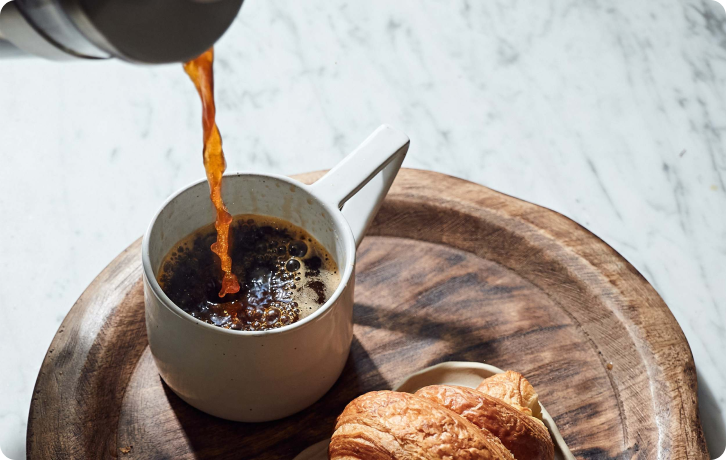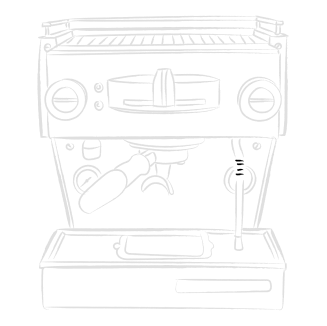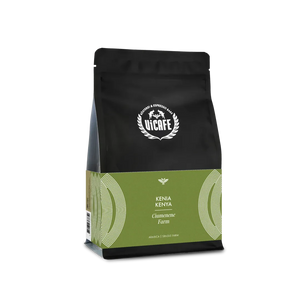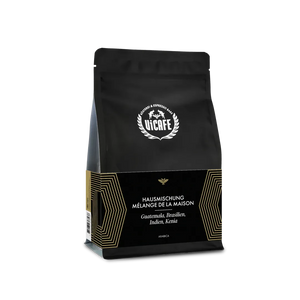
THESE GUIDES SERVE AS A GOOD PLACE TO START
The grinder you use, coffee you choose, and yes, even the water from your sink, can alter the taste in the cup. Every machine is different, so you'll want to think of these parameters more as guidelines than law.
French press
There are several advantages to preparing coffee with a French Press.
It’s easy to use, you can prepare a large amount of coffee in one go and have 1 litre of it ready in just 4 minutes - for everyone who needs a quick caffeine fix.
ingredients
55 - 70g coffee of your choice
Medium -coarse ground
ca. 1000g Water
What you'll need
French Press
Coffee grinder
ca. 1000g Water
Scale
Stopwatch
Water boiler
Method
1
Select your preferred specialty coffee.
2
Boil the amount of water needed for your brew.
3
Weighing of Beans: 60g/ Liter is a good Reference
4
Adjust the recipe to the size of your french press.
(Note: Is the taste of your brew to weak, increase the dose of the coffee).
5
Grinding of Beans: on a scale from 1-10, you will need a 7. This is a medium to coarse grind.
6
Pour hot water straight from the kettle. (due to the thermal mass of your brewing vessel and the coffee, the brewing temperature will naturally decrease to about 94°C, which is ideal for brewing of coffee).
7
Wait for a duration of approximately 4 minutes to gain the the full richness of coffee brew (if the brew is too weak and acidic, increase brewing time. Should the brew be too bitter, decrease the brewing time).
8
Break the coffee crust and smell the goodness.
9
At this point, you may now use the plunger and gently press it down. (note: press down the plunger to about 90% of the way, this ensures that the sediment continues to brew).
10
Enjoy your freshly brewed coffee!
barista tips
- Use freshly ground coffee if possible.
- Be brave and vary the amount of coffee until you find the optimal taste profile for you.
- Always brew with a scale.
- After brewing, the coffee should be consumed directly or transferred to another container (e.g. thermos) to avoid over-extraction and thus bitterness.

double espresso
Making a good espresso takes a little practice and a willingness to experiment.
It may take a few attempts until the elements of grind, weight and time are ideally matched.
ingredients
Portafilter machine
Portafilter
17g strainer
Coffee Grinder
Espresso-scale
Tamper
Stopwatch
Method
1
Select a high quality specialty coffee.
2
For a Doppio you will need a 17-19g sieve in a portafilter with a double outlet.
3
Clean and dry the sieve with a microfiber cloth.
4
Grind the beans to a medium grind and fill the sieve with the freshly ground coffee. Using the tamper press the ground coffee evenly and clean the edges of the portafilter.
5
Briefly let water run out of the brew group for 2 seconds so that coffee residues are removed. Insert the portafilter, place the cup(s) underneath and press the start button immediately so that the coffee does not burn.
6
Extract the Doppio (40g) into the cup(s). The perfect extraction takes between 25 to 28 seconds. If it takes longer, the doppio is over-extracted and tastes bitter. This means your grinder needs to be set coarser. If the extraction takes less than 25 seconds, the doppio is under-extracted and tastes sour. In this case, the grind should be set finer.
7
Immediately remove the portafilter, clean the sieve thoroughly and dry it so that the coffee grounds do not burn into the brew group.
8
Insert the portafilter again so that it maintains the appropriate temperature for the next extraction.
9
Enjoy your Doppio!
barista tips
- Use freshly ground coffee if possible.
- The more accurately you work with the stopwatch and espresso scale, the better the taste experience will be. The scale allows you to measure both the coffee powder and the amount of coffee in the cup.
- Does the coffee taste too sour? Either adjust the grind finer or increase the dosage slightly. Both measures extend the extraction time.
- Does the coffee taste too bitter? Set the grind coarser or reduce the dosage slightly. Both measures shorten the extraction time.



